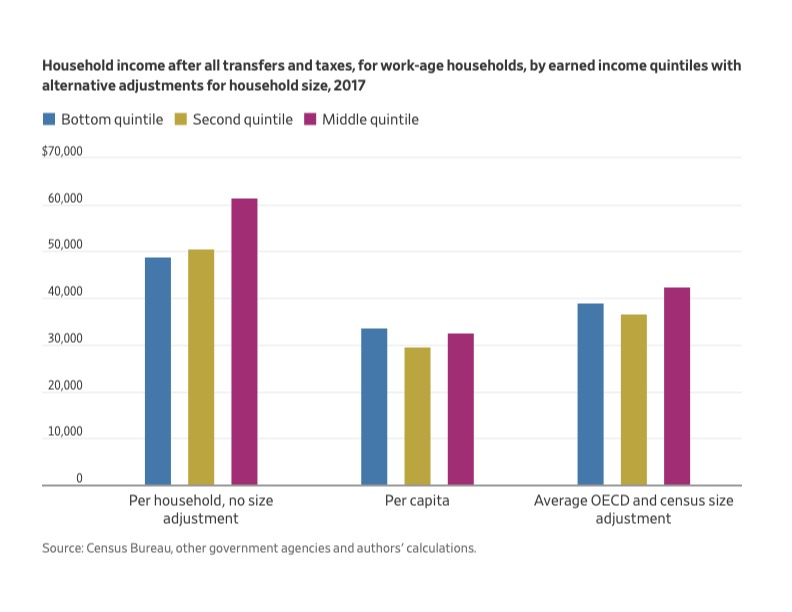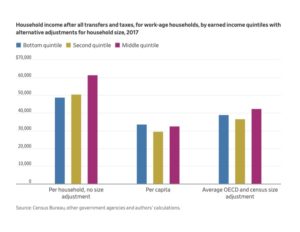

I used Labor Day to write my biweekly column for the Hoover Institution’s online publication Defining Ideas. Hey, that’s why it’s called Labor Day, right? So we can labor?
Here’s my Labor Day post, a day late.
Start with this quote from Phil Gramm and John Early, “Income Equality, Not Inequality, Is the Problem,” Wall Street Journal, August 29, 2022. (August 30 print edition.):
Real government transfer payments to the bottom 20% of household earners surged by 269% between 1967 and 2017, while middle-income households saw their real earnings after taxes rise by only 154% during the same period. That has largely equalized the income of the bottom 60% of Americans. This government-created equality has caused the labor-force participation rate to collapse among working-age people in low-income households and unleashed a populist realignment that is unraveling the coalition that has dominated American politics since the 1930s.
And:
Our most significant finding from correcting the census income calculations wasn’t the overstated inequality between top and bottom earners. It was the extraordinary equality of income among the bottom 60% of American households, regardless of employment status. In 2017, among working-age households, the bottom 20% earned only $6,941 on average, and only 36% were employed. But after transfer payments and taxes, those households had an average income of $48,806. The average working-age household in the second quintile earned $31,811 and 85% of them were employed. But after transfers and taxes, they had income of $50,492, a mere 3.5% more than the bottom quintile. The middle quintile earned $66,453 and 92% were employed. But after taxes and transfers, they kept only $61,350—just 26% more than the bottom quintile.
I haven’t checked Gramm’s and Early’s numbers but they appear to be well-sourced.
The bottom line is that the welfare state in the United States is now so extensive that for people in the bottom 60 percent, work pays off at best marginally. We need to make work pay better. Not by dictating higher wages; we know the problems with that. But by paring down the welfare state.
Note: The one thing I wonder about their numbers is how they account for spending on in-kind government welfare programs like Medicaid. Finkelstein, Hendren, and Luttmer found that Medicaid recipients value a dollar of Medicaid spent on them at only 20 to 40 cents. If Gramm and Early valued the Medicaid at $1 of benefit to the recipient for $1 spent on the recipient, they would be overstating the income of the bottom 20 percent. That would mean that the gap in income between the bottom quintile and the next two quintiles would be higher than their numbers show. However, it should be noted that one reason Finkelstein et al found such a low value is that “the uninsured pay only a small fraction of their medical expenditures. Put differently, if there was [sic] no Medicaid, this population would still receive some health care and would pay only a small share of its cost, likely due to the large amount of uncompensated care provided by hospitals.” So we might be back roughly to the dollar for dollar value of Medicaid spending, that I suspect Gramm and Early used, not being as big a problem as I first thought. Without Medicaid, they would still get a fair amount of medical treatment without working and being covered by health insurance.
The graph above is from their WSJ article.

READER COMMENTS
BC
Sep 6 2022 at 2:58pm
Beyond Medicaid, do these transfer payment calculations typically count state government in-kind benefits like public education? If not, then the income gaps are probably even smaller. Even if households across all income quintiles receive similar K-12 benefits, adding a fixed dollar amount to all incomes will narrow the percentage differences.
For that matter, we should probably include all in-kind government services — police, fire, defense, roads, etc. — as transfers. They are economically equivalent to giving everyone a voucher for purchasing such services, and vouchers are transfers. (Of course, there is only 1 government-monopoly provider, but that is irrelevant to the question of whether the service represents a transfer.) That would narrow income gaps even more.
Andrew
Sep 6 2022 at 3:11pm
This is shocking to me. I had heard previously that people in the bottom two quintiles often pay little to no taxes, but I had no clue that the bottom three quintiles have an 84%+ effective tax rate (including loss of benefits). This is crazy, not to mention the poor incentives to work, the incentive to avoid taxes with an 84% tax rate and to misreport income has to be huge.
This does start making more sense of the push to raise the minimum wage. A primary downside of minimum wage hikes is job loss, but if this doesn’t have much impact (dropping from 3rd to first quintile), then why not.
Monte
Sep 6 2022 at 8:00pm
Yes, making work pay better by paring down the welfare state is the solution. But the the problem to the solution is that the younger generations don’t want it. Gen Z and Millennials want more government, not less. And who can blame them when they’re courted with revelations about how Europeans enjoy free health care, long-term unemployment benefits, and liberal vacation time along with maternity and child care benefits:
“I would say that the European Welfare State is one of the great comparative advantages of Europe, if not in economic terms, at least in social and human terms. The welfare state has provided a buffer against the economic crisis, protecting Europeans from the kind of suffering Americans have gone through.” (Dominique Moisi, political analyst with the French Institute for International Relations).
Unfortunately, those who support the welfare state remain blissfully unaware (mostly by choice) of the prospect that it is unsustainable over the long term. Indeed, the less people know about important complex issues such as the economy, energy consumption and the environment, the more they want to avoid becoming well-informed, according to research published by the American Psychological Association.
The European model is precisely what the current administration and progressives hope to suffuse our free market economy with.
If successful, this will almost certainly negatively impact what we’ve held dear since our founding: self determination and personal responsibility. If we follow Europe, we’re in danger of losing those attributes.
BC
Sep 7 2022 at 4:43am
I would be wary of polls purporting to show support for various welfare state programs. There’s a pretty consistent pattern that support for various programs falls when people consider the costs, at least in America. For example, here’s a poll showing that support for college debt forgiveness craters dramatically if it will lead to higher taxes or tuition, primarily benefit higher income people, or cause more employers to require college degrees. Similarly, I’m not so sure that GenZ and Millennials would want a larger welfare state if it meant lower incomes and higher taxes. People living in European welfare states on average earn 15-30% less than Americans and pay higher taxes.
Paraphrasing Margaret Thatcher, the problem with the welfare state is that, eventually, you run out of Other People’s money. So, poll questions asking people whether they would still want welfare benefits even if their own taxes had to raised to pay for them are the most relevant.
BC
Sep 7 2022 at 4:44am
Sorry, here is the referenced poll on college debt:
https://www.cato.org/blog/new-poll-76-americans-oppose-student-debt-cancellation-it-drives-price-college-64-oppose-it
Monte
Sep 7 2022 at 1:17pm
No doubt. But that lack of support doesn’t seem to prevent these programs from passing muster. Voters merely determine which party’s polices get implemented, regardless of their popularity. If it weren’t for Manchin killing the Build Back Better bill, we would have witnessed the largest welfare increase in U.S. history, in spite of the fact that a majority of Americans were opposed to it, as is the case with the Student Loan Forgiveness act.
Knut P. Heen
Sep 7 2022 at 5:41am
What people in the US fail to realize about, for instance Norway, is that labor and sales taxes are so high that you have to do all the work on your house yourself. One hour of help costs $100+ unless you go to the black market.
Official reports will tell you that Norwegians are working less than Americans, but if you count hours worked to paint your house, upgrading the kitchen, gardening etc. Those numbers would be different.
The irony is that most people don’t understand that they are paying for all the “free” stuff by working evenings.
Thomas Hutcheson
Sep 7 2022 at 7:52am
I agree. The EITC should be used to encourage labor force participation. Shifting retirement and health insurance finance from a wage tax to a vat would help too
Comments are closed.